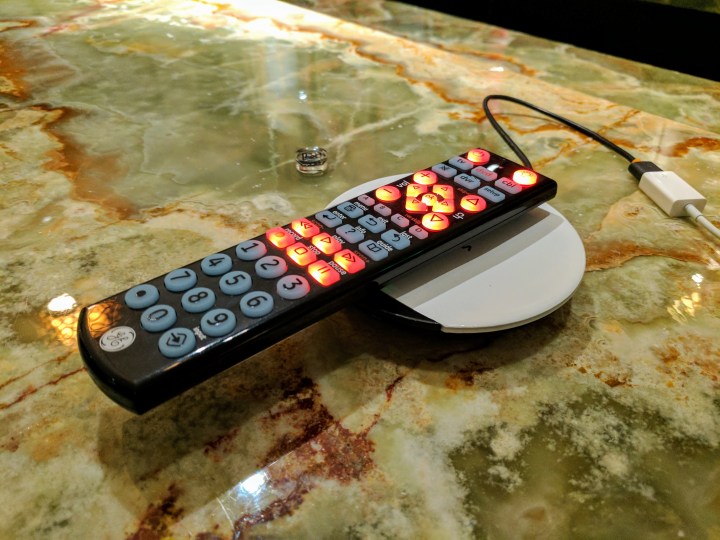
One company at the forefront is Energous. The company’s WattUp technology enables wireless charging in various forms — in a small, short-throw charging dock similar to Qi and PMA products on the market today; in a medium-distance “desktop” option intended for feet-long power transfer; and in a long-throw base station that beams energy from up to 15 feet in any direction.
Energous doesn’t actually produce devices, instead it supplies the chips required for wireless power transmission. Said chips leverage a 5.8GHz spectrum that is resistant to interference from Bluetooth and Wi-Fi. They rely on both beamforming, a wireless technique that improves transmission distance, and a receiver chip that converts the incoming radio signal into usable DC power. And they tap Bluetooth to ferry charging status and other data between the transmitter and receiver.
Energous demoed prototypes at 2016’s Consumer Electronics Show, but this year, the firm announced a milestone: It’s nearing commercialization. In December, Energous inked a deal with chip supplier Dialog Semiconductor to produce up to tens of millions of its wireless charging chips for products like hearing aids, Bluetooth trackers, computer mice, and TV remotes. The turnaround was almost instantaneous: Energous expects WattUp devices to begin emerging in earnest later in 2017.
At the firm’s Hard Rock Hotel suite in Las Vegas, company founder Michael Leabman walked Digital Trends through a few concepts.
The first, a wireless charge pad called the Miniature, looked a little like an off-the-shelf Qi pad. It had a parabolic arc in the center, like a small bowl, and packed a 10-by-10 millimeter chip — one of the company’s smallest antenna designs.
Unlike Qi charging pads, though, it did not require physical contact with the receiver to initiate the charging process — the WattUp-enabled TV remote at the Energous suite began charging a few inches from the charging pad’s center. It lacked a so-called “sweet spot,” the location Qi charging pads on which receivers must sit in order to charge. Energous’s charging pads transfer electricity to a device — or multiple devices –anywhere on or around them.
And they are cheap. Energous expects WattUp pads to cost no more than “a few dollars,” inexpensive enough to ship alongside fitness bands and Bluetooth trackers. “We didn’t want to add $15 to the cost of a $40 wearable,” Leabman said.
Energous had a few receiver prototypes on hand. Chipolo, the startup behind the eponymous Chipolo Bluetooth tracker, had a WattUp-enabled charger. Pegatron had reference fitness bands that charged over the air. And SK Telesys had a smart credit card.
The next stop along Energous’ tour, the WattUp “desktop” form factor, was a beast from the same cloth. The mocked-up transmitter, which looked a little like a home theater soundbar, packed enough power to beam electricity several inches around it. In a demonstration, Leabman flipped on virtual toggles in an iPad app to charge a wireless mouse and keyboard.
The distance comes at a cost. Achieving it requires multiple antennas, amplifiers, and other components, a total retail value Leabman expects to total significantly more than the charging pad — likely between $50 and $100.
Lastly, Leabman demonstrated Energous’ most impressive product — a long-distance base station. He carried a WattUp-equipped TV remote — the keys of which illuminated when it received energy — around a mock living room, the base station left sitting on the entertainment console. Even at almost 20 feet, it didn’t show signs of losing a charge.
It’s a neat demo, but Leabman said the true beauty of the WattUp system is its scalability. The WattUp’s antenna design can conform to almost any size and shape and easily stack together to build a more powerful base station — the long-range prototype base station, he explained, is essentially two WattUp desktop transmitters tethered together.
The other is WattUp’s Lowdown management system, Leabman said, a free cloud-based management layer akin to a Wi-Fi router’s settings page. From an internet dashboard or mobile app, WattUp transmitter owners can see a geographic map of their devices’ locations, the amount of power they are consuming, and the identity of receivers connected to them. Administrators can set access rules, too, denying certain devices, permitting access at certain times, or prioritizing, say, a smartphone over a security camera.
As Energous barrels toward the consumer market at full force, it’s confident in its ability to gain a foothold. Rumors persist that the company has clandestinely agreed to supply the charging peripherals for Apple’s next iPhone, a charge which Leabman neither confirmed nor denied. But he said that that company has partnered with several large consumer electronics companies — the names of which he wasn’t willing to divulge — for products due out by 2018.
As for the technology’s potential regulatory barriers, Leabman’s believes that WattUp’s technology will pass the Federal Communications Commission’s muster. Already, the FCC approved Energous’ Miniature reference design and it’s working with Energous engineers to ensure its long-range products stay within the acceptable boundaries.
“We’re confident the platform,” Leabman said. “The sky’s the limit.”
Editors' Recommendations
- The best cheap wireless charging pad deals we’ve found this Prime Day
- Moshi launches 10-year warranty for all its products, reveals several new items

